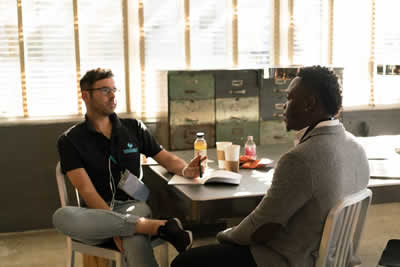Our working lives are made up of a series of decisions - some of which carry more weight than others. Obviously, deciding which Post-It notes to order won’t have too many consequences, but other choices can mean the difference between success and failure. As such, decision-making at work should operate on the same principles as the stock market. But don’t worry! We’re not suggesting that you need to start studying The Wolf of Wall Street - it’s more about balancing risk, using clear-eyed reasoning and weighing up the options to maximise returns.

Afetr all, investment is all about using the information available to make savvy decisions - so, not too different from the average workplace, is it?
Diversification in the Workplace: Spreading Your Bets
You’ve probably come across the term “hedging your bets” and this all boils down to not putting all of your eggs in one basket. Experienced investors know that gambling all of their cash on one thing is a bad idea and so, instead, they “hedge their bets” by spreading their funds out across two or more investment opportunities. You can do the same thing in the workplace by divvying up talent, time and budgets between different projects in order to limit risk and maximise results.
An example of this would be an investor deciding to
buy Austrian Silver Philharmonic coins - he or she wouldn’t dream of doing so without putting in the legwork to calculate current and future value, potential demand and stability. The same goes for the workplace; you can gain results by looking at the whole picture and, just as importantly, upskilling and developing the skills of your employees for supersized productivity. This means, essentially, future-proofing your investment in the event that a key employee moves on or priorities change.
Risk Assessment: Quantifying Uncertainty at Work
For high-powered city types, risk assessment is all about using knowledge and experience to figure out how big or small any potential losses might be - and this is pretty darn important as those losses can run into millions of pounds. While your business may be a little more modest, the same principles apply.

Don’t worry - it’s not as complicated as you might think; here’s how it works. Take a long hard look at the plans for your project and then write down any potential risks that come to mind. Next, grade these risks by how likely they are to happen and what the possible consequences might be. Once you get your head around this process, you can bring on board some useful tools like SWOT analysis to help inform your risk assessment. It’s also a great idea to get your team to provide input as diverse perspectives can often uncover blind spots that may be running under your radar.
Return on Investment (ROI): Measuring Workplace Impact
Return on Investment or ROI is the secret sauce that fuels most businesses - and for good reason. This term is a way of calculating how much time, money and effort a project will require and then offsetting that with
how much profit you make. A return - i.e. the benefit - doesn’t necessarily have to mean cash profit; it can also mean increased productivity, a better work culture or cost savings. Start by deciding what your return will look like and then counter this with everything required to make it happen. This is how great decision-making starts. Hastily executed projects rarely work out and so carrying out testing, running pilot projects and staying open to new tools and processes can all improve your chances of success.
Reasoning Under Uncertainty: Making Informed Decisions
In the investment world, uncertainty is a constant companion and, while luck plays a part, so too does critical thinking along with experience and reasoning.

Any broker will tell you that little good can come from making decisions in a hurry; in fact, this usually leads to wasted resources and bigger problems down the road.
Just like a good investor, collate all of the information that is available to you - even if it's not fully complete - and examine it to identify any recurring patterns. Next, use your reasoning skills to envisage different results and consequences of making certain decisions. This process is known as
due diligence and is a really important part of making sure that risk and opportunity are balanced before hitting the start button on a project.
Let’s be honest - not every professional action we take works out - but that’s fine. Get into the habit of revisiting past projects and the decisions that were made. Getting used to reviewing your previous choices helps to keep you disciplined and will, over time, allow you to make faster and smarter decisions.
Tips for Integrating Investment Principles in a Workplace Setting
Right then, we’ve given you a basic idea - but does it work in real-life?

Absolutely. When you start thinking like an investor, good things happen including a long-term view of success, so let’s look at some tips on how to put this into practice:
- Rate and review - The only way to improve is to look at what’s gone before and this is done by creating a simple decision review process. Putting in place a standard procedure to review the good, the bad and the ugly of past projects helps you learn and make smarter choices.
- Action stations - Establish a process whereby certain thresholds such as performance or benefit are achieved before funneling more resources into a project. This helps to reduce waste and teaches you better discipline.
- The long and the short of it - A quick win is rarely more valuable than long-term success so you should always pause to weigh up short-term gains and long-term success or stability.
- Opportunity knocks - Just because an opportunity is not viable right now, that doesn’t mean it won’t be in the future. Monitor and track every potential project or idea and revisit them periodically to see if the time is right.
- Scenarios are the key to planning - Always use projections and best / worst case scenarios to see how a project might track from inception to conclusion.
- The courage of your convictions - Risk is a necessary part of any business and can lead to great things; as long as you’re smart. If an idea is a bit off the wall, try a small-scale test or pilot before committing to going full tilt boogie.
Wrapping up
The world just keeps getting more competitive, so you need every advantage you can get - and fortune favours the brave. Put on your investor hat and learn to make great decisions through calculated risks backed up by clear and critical thinking.

Once you get into the habit of treating every important decision like your retirement portfolio, you are, essentially, retraining your thinking to be sharper, smarter and more confident. Which is, after all, where you want – and need – to be, isn’t it?

If you'd like to learn more about accounts and finance, why not take a look at how we can help?
Boost your understanding of accounts with our online courses.
RRP $65 – limited time offer just
$23.99






























